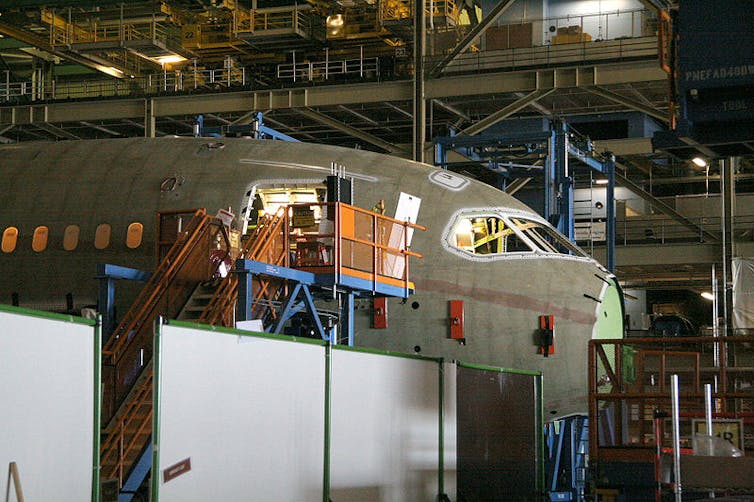What do Novak Djokovic’s tennis racket, Mark Webber’s F1 car and the new Boeing 787 have in common? They all extensively rely on composite materials.
A composite material is a strategic combination of multiple materials that results in a material with better properties than its individual components. In other words, by combining multiple materials, composite materials allow for a weakness in one material to be rectified by a strength in another.
Composite materials have been around for several decades but technological breakthroughs in engineering, materials sciences and manufacturing have resulted in a significant increase in their use over the past 20 years. Composite materials can now be found in aerospace, commercial and race cars, marine vessels, sporting goods and in many other industries.
Composites typically consist of two main components: fibres (providing great tensile strength and flexural stiffness), and a “matrix” holding the fibres together (providing compressive strength and controlling the overall shape).
For instance, the “carbon fibre + epoxy resin” combination is widely used in aerospace. Another example is the “carbon fibre + PEEK (a crystalline polymer)” combination, which is a biomaterial composite used in spinal implants.
Composite materials: a tricky combination
Composite materials typically result in materials with increased strength, toughness and stiffness. Compared to metals, they offer a better strength- and stiffness-to-weight ratio, better corrosion properties, and better fatigue resistance.
In aerospace, this results in planes that last longer and require less maintenance work – a point referenced by Qantas CEO Alan Joyce last week.
Composite materials also mean a lighter aircraft, resulting in lower fuel consumption and a reduced carbon footprint.
But there are disadvantages. For a start, composite materials don’t come cheap. Both material and equipment costs are high and constitute a considerable investment (up to several millions of dollars for a single set-up).
Still, prices overall have come down over the past decade which make composites more accessible and suitable for large-scale projects, such as the ones found in aerospace.
Also, special skills are required to appropriately handle composites. Indeed, the manufacturing process is labour-intensive and high engineering materials knowledge is required. New composites training courses are starting to appear to help businesses adequately train their staff, but these are expensive.
Composite materials also require special storage and handling. They usually come in “prepreg” form (fibres pre-impregnated with resin) that need frozen storage and have limited shelf-life (a few weeks/months).
Finally, there are serious concerns around health hazards for workers handling composites. Health issues include complications from inhaling fibres and exposure to suspected carcinogens. Indeed, several composite material components are classified as hazardous.
Boeing 787 and Airbus A350: pushing the limits of commercial aerospace composite structures
Boeing and Airbus have both increasingly embraced composite structures over the years, particularly with their latest aircraft models. Both the Boeing 787 and the Airbus A350 feature more than 50% of composite materials (by weight) - the largest amount ever used on a commercial aircraft.
Airlines, such as Japan’s ANA, are currently using the Boeing 787, while Airbus is still working on the A350 with a possible release date around 2013-14.

The process to commercialisation isn’t without several challenges as the aircraft has to go through a tightly regulated certification process before going into full production.
The US Federal Aviation Administration (FAA) and the European Aviation Safety Agency (EASA) are in charge of investigating aircraft safety and delivering the required certification.
In October last year, America’s Government Accountability Office (GAO) released a report identifying concerns about the limited information on the behaviour of these new aircraft made of composite structures, as well as technical issues relating to the unique properties of composite materials.
Australia’s ATSB (Australian Transport Safety Bureau) also investigated the challenges around using composites and released a report back in 2008 discussing composite materials’ capabilities and safety.
In August last year, Boeing finally got it right when the 787 was certified by both the FAA and EASA. It was a long time coming – Boeing was nearly three years behind schedule and billions of dollars over budget. However, with a backlog of more than 800 orders, there is clearly a strong demand for the 787.
Automated fibre placement: using robots to make composite structures
As the use of the composites structures increases, so does the manufacturing production rate required to meet that demand. Indeed, Boeing is planning to produce ten Boeing 787s per month by the end of next year.
As a consequence, the aerospace industry has been turning to automated processes. Automation has been investigated as a solution for composite manufacturing since the 1970s. But the large equipment cost required (up to several million dollars) limited their mainstream implementation.
For the last ten years, low-cost robotic arms have been used for a number of manufacturing processes. These low-cost robotic arms became prime candidate for a cheap, reliable and flexible composite manufacturing solution.
Robotic Fibre Placement (RFP) heads started to appear on the market. These placement heads can lay composite materials (using different methods depending on the part at hand) either in a mould or directly on to a desired structure (see video below).
Composite placement is a form of additive manufacturing (as with 3D printing) as it “adds” material, layer after layer - a very powerful method that allows for quick implementation, and more flexibility when dealing with complex structures, such as the ones found in aerospace.
But robotic fibre placement has to be further developed. It is slower than other comparable (but more expensive) automated solutions. There are still issues around the “laying” of the material on curved structures and there are quality issues around defects such as voids, inadequate compaction and consolidation of the material.
In with the new
It’s a very exciting time in aerospace at the moment. The need to manufacture composite structures at higher rates has pushed researchers in industry and academia to further innovate and develop novel manufacturing methods.
In the long-term, this process will offer immense benefits for the aircraft manufacturers, the airlines and the passenger.
The ultimate goal here is a bold one: by using composite materials, aircraft manufacturers are aiming to raise the bar for safety, fuel economy and environmental sensitivity – making your trip safer and greener.

